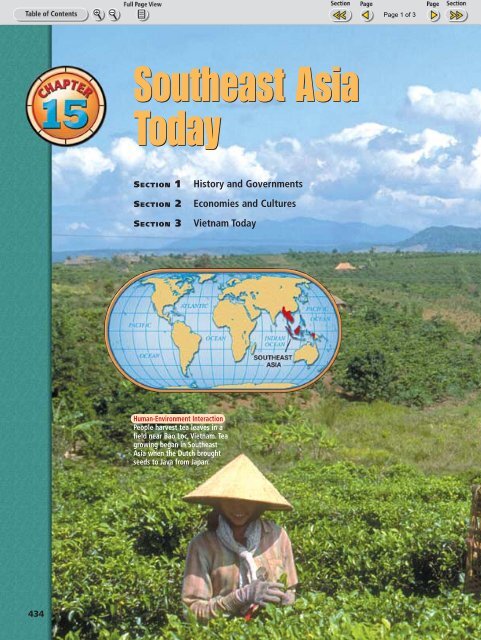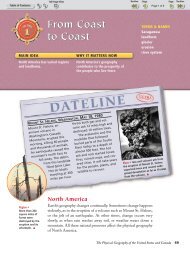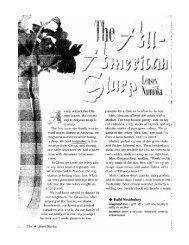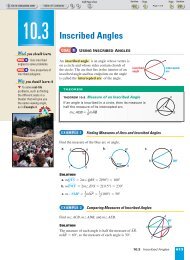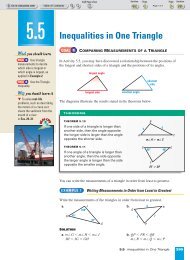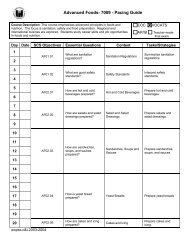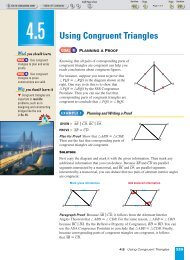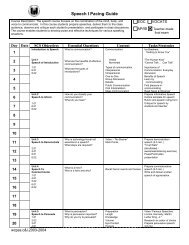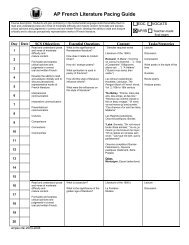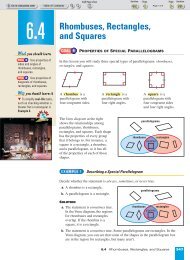Chapter 15 Section 1 - Nexuslearning.net
Chapter 15 Section 1 - Nexuslearning.net
Chapter 15 Section 1 - Nexuslearning.net
Create successful ePaper yourself
Turn your PDF publications into a flip-book with our unique Google optimized e-Paper software.
434-435 <strong>Chapter</strong> <strong>15</strong>/EH 10/17/02 1:03 PM Page 434<br />
434<br />
Southeast Asia<br />
Today<br />
SECTION 1 History and Governments<br />
SECTION 2 Economies and Cultures<br />
SECTION 3 Vietnam Today<br />
Human-Environment Interaction<br />
People harvest tea leaves in a<br />
field near Bao Loc, Vietnam. Tea<br />
growing began in Southeast<br />
Asia when the Dutch brought<br />
seeds to Java from Japan.
434-435 <strong>Chapter</strong> <strong>15</strong>/EH 10/17/02 1:03 PM Page 435<br />
How has migration influenced<br />
Southeast Asia’s culture?<br />
Movement • The first people to live in mainland Southeast<br />
Asia probably came from southern China and South Asia. Later,<br />
the ethnic groups known as the Mon, Khmer, and Thai slowly<br />
moved south into the Indochinese Peninsula, where they set up<br />
rich kingdoms. Over the centuries, the region’s wealth attracted<br />
Chinese settlers and merchants from India and Arabia. All these<br />
groups brought their unique cultures and religions with them.<br />
These and other influences blended to form the culture of<br />
Southeast Asia.<br />
What do you think?<br />
♦ How does the migration of<br />
people into a region affect<br />
its culture?<br />
♦ What challenges face<br />
modern nations made up<br />
of many different ethnic<br />
groups and religions?
436-441 <strong>Chapter</strong> <strong>15</strong>/EH 10/17/02 1:03 PM Page 436<br />
BEFORE YOU READ<br />
>> What Do You Know?<br />
Before you read the chapter, think about what you know about Southeast Asia.<br />
What countries make up this region? What do you know about the region’s<br />
governments and economies? Have you ever seen a movie about the Vietnam<br />
War? What do you know about Vietnam today? Recall what you know from<br />
other classes, what you have read, and what you have seen on television.<br />
>> What Do You Want to Know?<br />
In your notebook, record what you hope to learn from this chapter.<br />
READ AND TAKE NOTES<br />
Reading Strategy: Drawing Conclusions To draw conclusions,<br />
look at the facts and then use your common<br />
sense and experience to decide what the facts mean.<br />
Use the chart below to gather facts and draw conclusions<br />
about Southeast Asia.<br />
• Copy the chart into your notebook.<br />
• As you read, record facts and examples that answer<br />
each question. Look for specific information, as<br />
shown.<br />
• After you read, review the facts and examples,<br />
decide what they mean, and record your<br />
conclusions.<br />
How are Southeast Asian nations linked<br />
to other countries?<br />
What forms of government are in<br />
the region?<br />
What factors affect economies in<br />
Southeast Asia today?<br />
What factors shape cultures in<br />
the region?<br />
What are the effects of the Vietnam War?<br />
436 CHAPTER <strong>15</strong><br />
Culture • Puppets made<br />
from water buffalo hides<br />
are used in the ancient art<br />
of shadow theater. <br />
Place • Singapore is a busy and wealthy city<br />
in Southeast Asia. <br />
Facts/Examples Conclusions
402-407 <strong>Chapter</strong> 14/EH 10/17/02 1:00 PM Page 403<br />
History<br />
MAIN IDEA WHY IT MATTERS NOW<br />
The movements of people and<br />
ideas through the nations of South<br />
Asia have produced a varied and<br />
exciting history.<br />
Similarities and differences among<br />
these nations have led to both<br />
development and conflict.<br />
RAMNURGER, NEAR BENARES ON THE GANGES RIVER, APRIL 19, 1796<br />
A British ship anchored in<br />
the river yesterday after<br />
sailing many months from<br />
England. Today, boatmen<br />
and British sailors outfitted<br />
in our native cotton dress<br />
have been working madly<br />
to load the ship. They hope<br />
to sail before the monsoon<br />
winds and storms begin.<br />
Hundreds of boxes of tea,<br />
spices, and cotton fabric<br />
will travel back to England.<br />
Movement • Despite great risk, ships from Great Britain, France,<br />
and Portugal sail to India and other parts of South Asia to carry<br />
back valuable spices, tea, and other goods. <br />
Islam Comes to India<br />
The coast of India has been a site of trade for centuries. Arabs<br />
were trading along the coast of India a thousand years before the<br />
British arrived. Early in the eighth century A.D., Muslims from<br />
Arabia conquered northwest India. They converted many of<br />
the people of this region to their religion, Islam. Even today,<br />
the people of this region (what is now Afghanistan and Pakistan)<br />
are Muslim.<br />
TERMS & NAMES<br />
Mughal Empire<br />
Indian National<br />
Congress<br />
Muslim League<br />
Mohandas Gandhi<br />
India and Its Neighbors 403
402-407 <strong>Chapter</strong> 14/EH 10/17/02 1:00 PM Page 404<br />
Location •<br />
The Hindu Kush<br />
Mountains in<br />
northern<br />
Pakistan helped<br />
to keep out<br />
invaders. <br />
Culture • Akbar,<br />
shown here<br />
crossing the<br />
Ganges, had<br />
his life story<br />
told in words<br />
and pictures in<br />
the Akbarnama,<br />
or The Memoirs<br />
of Akbar. <br />
404 CHAPTER 14<br />
Turks and Mongols Beginning in the<br />
11th century A.D., Turkish Muslims from<br />
what is now Afghanistan attacked northwest<br />
India, replacing the Arabs. By 1206,<br />
the Turkish kingdom stretched south to<br />
the Deccan Plateau. The region was ruled<br />
from the city of Delhi by a sultan. During<br />
this time, Mongols from Central Asia<br />
began spreading west and south. Because<br />
of the mountains in the northeastern part of South Asia, the<br />
Mongols never invaded the region. Many people who were threatened<br />
by the Mongols fled across the mountains into South Asia.<br />
These artists, teachers, government officials, and religious leaders<br />
brought with them their culture and learning.<br />
The Mughal Empire<br />
In the year <strong>15</strong>26, Babur (BAH•buhr), a Mughal (moo•GUL)<br />
ruler and a Muslim, invaded southward with his army.<br />
Eventually, his kingdom included northern India and land west<br />
into Afghanistan. Babur involved local leaders in his government<br />
and built trade routes, strengthening his rule. Babur’s reign was<br />
the beginning of the great Mughal Empire.<br />
Akbar, Mughal Emperor The third Mughal emperor,<br />
Akbar, was a strong and intelligent leader who was<br />
careful to include both Hindus and Muslims in his government.<br />
His policies made India a place where both<br />
Hindus and Muslims could live in peace. He taxed<br />
people according to the size and value of their land,<br />
which meant that poor farmers were not taxed as heavily<br />
as they had been before. Akbar was a strong supporter<br />
of the arts. He provided studios for painters and<br />
gave awards to the best among them. He also created<br />
a position for the official Hindu poet of the nation.<br />
End of the Empire During the period of the Mughal<br />
Empire, many new trade routes over land and water<br />
were established, making travel between regions easier.<br />
The trade routes also connected the empire with<br />
other parts of the world. In this way new ideas and<br />
inventions made their way into South Asia. Then, in<br />
the year 1707, with the death of the last Mughal<br />
emperor, the empire eventually collapsed.<br />
Vocabulary<br />
sultan:<br />
emperor<br />
Vocabulary<br />
Mughal:<br />
Muslim Turks<br />
from what is<br />
now Turkistan<br />
A. Drawing<br />
Conclusions How<br />
would trade routes<br />
help to strengthen<br />
an empire?
402-407 <strong>Chapter</strong> 14/EH 10/17/02 1:00 PM Page 405<br />
GEOGRAPHY<br />
SKILLBUILDER:<br />
Interpreting a Map<br />
1. Location • The<br />
Mughal Empire in<br />
1707 was located in<br />
which present-day<br />
nations?<br />
2. Movement • In<br />
what directions did<br />
the Mughal Empire<br />
grow from <strong>15</strong>24 to<br />
1707?<br />
N<br />
The Mughal Empire, <strong>15</strong>24–1707<br />
Tropic of Cancer<br />
Arabian<br />
Sea<br />
AFGHANISTAN<br />
PAKISTAN<br />
Indus R.<br />
Bombay<br />
.<br />
R<br />
s<br />
u<br />
d<br />
n<br />
I<br />
Lahore<br />
Delhi<br />
I N D I A<br />
Madras<br />
NEPAL<br />
Ganges R.<br />
Calcutta<br />
Bay of<br />
Bengal<br />
BHUTAN<br />
BANGLADESH<br />
60°E 70°E<br />
80°E 90°E<br />
Under Babur (<strong>15</strong>24–<strong>15</strong>30)<br />
Under Akbar (<strong>15</strong>56–1605)<br />
Under Aurangzeb (1658–1707)<br />
0<br />
250 500 miles<br />
0 250 500 kilometers<br />
Arrival of the British<br />
In 1600, Queen Elizabeth I of England gave trade rights to the<br />
East India Company, an organization of English merchants, to<br />
trade in India and East and Southeast Asia. The Mughals agreed<br />
to let the British set up factories<br />
and trading centers. The<br />
East India Company shipped<br />
spices, tea, cotton, silk, indigo<br />
(used for dyeing), sugar, and<br />
saltpeter (used for gunpowder)<br />
to England. Gradually, the<br />
British increased their power.<br />
By 1818, after the Rajputs and<br />
other groups agreed to be<br />
ruled by the British, Great<br />
Britain’s strength in the region<br />
was undeniable.<br />
10°N<br />
Movement • The<br />
British brought<br />
railroads to India,<br />
such as this<br />
steam train in<br />
Darjeeling,<br />
shown in 1930. <br />
India and Its Neighbors 405
402-407 <strong>Chapter</strong> 14/EH 10/17/02 1:00 PM Page 406<br />
India’s Neighbors and Great Britain In 1796, Great Britain took<br />
possession of the island nation of Sri Lanka, then called Ceylon,<br />
and the island nation of the Maldives. The nations of Nepal,<br />
Bhutan, and Afghanistan never became colonies of Great Britain,<br />
though the British tried to colonize Afghanistan. Nepal and Bhutan<br />
depended on their mountainous frontiers to keep out foreigners.<br />
Making India British The British army and navy, merchants, and<br />
Christian missionaries came to India, bringing new technology for<br />
railroads, the telegraph, steamships, and new methods of irrigation.<br />
They also introduced the British legal system, with new laws<br />
regarding landownership, and made English the official language.<br />
Indians responded to the British in different ways. Some chose<br />
to live just as they had before the British arrived. Others chose to<br />
interact economically with the British by working for and with<br />
them while maintaining their traditions. Still others studied the<br />
British traditions and adopted what seemed useful while keeping<br />
their own traditions. Among the higher castes, parents sent their<br />
children to British schools so that they could learn English and<br />
become successful.<br />
Independence<br />
In 1885, the Indian National Congress was formed to provide<br />
a forum where Indians could discuss their problems. Muslims<br />
formed the Muslim League in 1906. After World War I,<br />
Indians began to think of independence. They had a great leader<br />
in Mohandas Gandhi.<br />
Mohandas Gandhi (GAHN•dee) Gandhi was born in India in 1869. He learned<br />
about discrimination when, as a young boy, he saw that no matter how wealthy and<br />
well educated Indians were, they were treated as second-class citizens by the British.<br />
Gandhi studied law in England and then spent the rest of his life working for justice<br />
for the Indian people.<br />
He encouraged his followers to use nonviolence to resist the British and bring<br />
about social change. Gandhi believed that the forces of goodness and truth had powerful<br />
effects on people. As part of this belief, he went on hunger strikes and organized<br />
labor strikes and marches to force the British to grant India its independence.<br />
The Indian people call Gandhi the Mahatma, which means “Great Soul.” They<br />
honor him as the father of their nation. His ideas have influenced many people who<br />
have worked for justice around the world.<br />
406 CHAPTER 14<br />
B. Comparing<br />
Which changes<br />
brought by the<br />
British were<br />
cultural and<br />
which were<br />
technological?
402-407 <strong>Chapter</strong> 14/EH 10/17/02 1:00 PM Page 407<br />
Vocabulary<br />
monopoly:<br />
The sale of a<br />
good by only<br />
one company<br />
On the Unit Atlas<br />
Map on page<br />
368, find India,<br />
Pakistan, and<br />
Bangladesh. Before<br />
independence, this<br />
entire region was<br />
India.<br />
Gandhi used nonviolence to<br />
impress upon the British the need for<br />
independence. He also wanted all<br />
Indians to be treated equally. He<br />
wanted women to have the same freedoms<br />
as men. He encouraged Hindus<br />
and Muslims to find peaceful ways to<br />
solve their problems. For example, to<br />
protest the British monopoly of salt,<br />
Gandhi led a 240-mile walk to the<br />
coast to gather sea salt.<br />
Eventually, Great Britain realized<br />
that it would have to leave India, but<br />
the Indian National Congress and the<br />
Muslim League disagreed about how<br />
the new government would be formed.<br />
Muslims were afraid of losing power<br />
because Hindus were the majority in<br />
India. The solution was to divide India into two separate countries,<br />
India for the Hindus and Pakistan for the Muslims. The two<br />
countries were formed and granted independence in 1947. Sri<br />
Lanka became independent in 1948, and the Maldives in 1965.<br />
SECTION ASSESSMENT<br />
Terms & Names<br />
1. Identify: (a) Mughal Empire (b) Indian National Congress<br />
(c) Muslim League (d) Mohandas Gandhi<br />
Taking Notes<br />
2. Use a Venn diagram like the one<br />
below to compare and contrast the<br />
rule of the Mughals and the British<br />
in India.<br />
Mughals British<br />
Main Ideas<br />
3. (a) How did Islam reach India?<br />
(b) Name three achievements of<br />
the Mughal emperors.<br />
(c) Why did the British colonize<br />
India?<br />
Movement •<br />
Gandhi led his<br />
countrymen to<br />
the coast at<br />
Dandi to protest<br />
the British sale<br />
of salt. <br />
Critical Thinking<br />
4. Making Inferences<br />
Do you think it was easier for rich<br />
Indians or poor Indians to live<br />
under British rule? Explain.<br />
Think About<br />
◆ how Indians responded to British<br />
rule<br />
◆ the opportunities for Indians of<br />
different castes<br />
Imagine being a reporter for an Indian newspaper and attending a speech given by Gandhi. Write a<br />
short article reporting on the speech and giving your reaction to it.<br />
India and Its Neighbors 407
442-443 <strong>Chapter</strong> <strong>15</strong>/EH 10/17/02 1:03 PM Page 442<br />
Theater<br />
and Dance<br />
In ancient times, theater and classical dance<br />
productions were held in the temples and<br />
royal courts of India. Spectators watched<br />
dancers act out stories of Hindu gods and<br />
myths, especially from famous epics. The<br />
two most famous epics are the Ramayana<br />
(ruh•MAH•yuh•nuh) and the Mahabharata<br />
(MAH•huh•BAH•ruh•tuh). Folk dancing,<br />
another dance form, was popular in rural<br />
areas. Modern dance in Southern Asia<br />
includes elements of both classical and<br />
folk dancing.<br />
442 UNIT 5<br />
The Legacy<br />
of Southern Asia<br />
Architecture<br />
Even before the rise<br />
of Buddhism in the 5th<br />
century B.C., people in<br />
India made burial mounds<br />
for their dead. When the Buddha died, similar<br />
mound-shaped structures called stupas<br />
became symbols of his death and of<br />
Buddhism. Stupas became more elaborate<br />
over time. This architectural form spread<br />
throughout the Buddhist world and can be<br />
found in the pagodas—religious buildings—of<br />
Korea, Japan, and China, as well as<br />
in shrines in Sri Lanka and temples in Java.
442-443 <strong>Chapter</strong> <strong>15</strong>/EH 10/17/02 1:03 PM Page 443<br />
Cities<br />
One of the first cities in the world, Mohenjo-Daro, was built along<br />
the Indus River in what is now Pakistan. After archaeologists discovered<br />
the 4,000-year-old city in 1922, they spent years excavating its<br />
ruins. What they unearthed was a city laid out in a grid pattern, with<br />
streets, houses, assembly halls, storerooms, public baths, and a sewer<br />
system. Many modern cities are laid out in grids, and some cities in<br />
India have public baths similar to the ones found in Mohenjo-Daro.<br />
Black Tea<br />
Though tea bushes were found growing<br />
wild in Assam, India, in the 1820s, it was<br />
not until the mid-1880s that India<br />
began to export tea. Workers used a<br />
process that turned green leaves to a<br />
brownish black color to produce a blend<br />
known as black tea. Though tea had<br />
been grown in China for more than<br />
3,000 years, by 1888 England was<br />
importing more tea from Southern Asia<br />
than from China. Today, some of the<br />
best black teas come from India.<br />
Find Out More About It!<br />
Study the text and photos on these<br />
pages to learn about inventions,<br />
creations, and contributions that<br />
have come from Southern Asia. Then<br />
choose the item that interests you<br />
the most and use the library or the<br />
Inter<strong>net</strong> to research the subject and<br />
learn more about it. Use the information<br />
you gather to create a<br />
diorama to share with the class.<br />
RESEARCH LINKS<br />
CLASSZONE.COM<br />
Sanskrit Language<br />
Sanskrit, the oldest written language<br />
of India, was first brought to India<br />
around <strong>15</strong>00 B.C. The language has<br />
distinctive sounds, as well as complex<br />
grammar rules. Some of India’s<br />
modern languages—Hindi, Bengali,<br />
and Punjabi—are based on Sanskrit.<br />
Though by 100 B.C. Sanskrit was no<br />
longer being spoken, it is still used<br />
in many Hindu ceremonies and in<br />
scholarly works and teachings.<br />
Southern Asia 443


